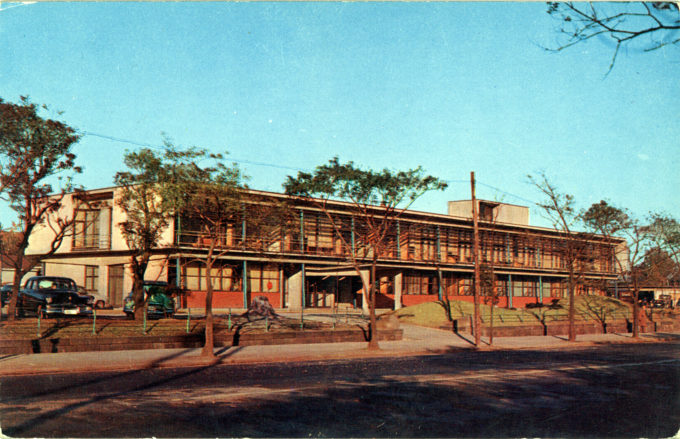
Reader’s Digest Building, Tokyo, c. 1955. A not-particularly striking image of the building, designed by Antonin Raymond who had had an architectural practice in Japan before the Pacific War. But, the building, under construction from 1949-1951, was transforming on multiple levels. While Raymond used the latest concrete construction techniques available at the time, he also sought to blend traditional Japanese and modern western architecture and to follow ‘the Japanese respect for proper orientation, closeness to nature, and use of material in their natural state,’ including sculpting the landscape into bulbous mounds, with a stream and reservoir added for natural air-conditioning.
“The postwar rebuilding of Japan began masterfully with a work of [Antonin] Raymond’s Reader’s Digest Building at Takebashi, the first ‘permanent’ new building in Tokyo since the end of World War II.
“Raymond had petitioned General MacArthur for permission to reenter occupied Japan in order to participate in the work of reconstructing the country. Arriving in Tokyo in 1947, he discovered former staff members had painstakingly preserved all documents and drawings left behind ten years earlier and only awaited his instructions to reopen the office.
“… The Reader’s Digest Building was a particular concern of [Digest owner] Mrs. DeWitt Wallace, who had first tried to interest Frank Lloyd Wright in the job. She expected a design that would serve Japan as a model of the best America had to offer, and she commissioned it from Raymond when he returned to his New York office from Tokyo in 1949. The site he acquired for the magazine was opposite the Hirakawa Gate of the Imperial Palace, about a kilometer north of Wright’s Imperial Hotel, and Raymond’s conscious intention in choosing it was to establish ‘a pattern for future city-planning by setting the building into a garden.’
“… The building for Mrs. Wallace was a two-story longitudinal structure recalling [Raymond’s] Tokyo Golf Club in scale and layout, though not in its construction or details … [T]he Reader’s Digest Building was to benefit from a decade of prior activity in America during the war on Raymond’s part .. [T]he latest technical innovations and materials available in the United States were now copied in Japan under his supervision. These included such things as both asphalt and acoustical tiling, under-floor ducts for electricity and telephones, fluorescent lighting, a heat-pump system, and floor-to-ceiling glazing.
“… All in all, it seems natural to consider the Reader’s Digest Building as the masterpiece of the architect’s long and varied career.”
– “The Making of Modern Japanese Architecture: 1868 to the Present”, by David B. Stewart, 1987

